- Quick Read
- Deep Read ( 6 Min. )
In Today’s Issue
- Capturing carbon emissions: pragmatic solution or costly distraction?
- ‘Constitutional carry’ comes to Texas. The trend in five charts.
- Denmark evicts ‘ghetto’ residents to integrate them. Will it help?
- Everything in its place: From stolen art to endangered monkeys
- Sports team owners and the call for racial justice
Monitor Daily Podcast
- Follow us:
- Apple Podcasts
- Spotify
- RSS Feed
- Download
TODAY’S INTRO
It takes a Waffle House to raise a high school graduate
Graduating from high school is a major milestone. You and your friends put on the unifying robes of medieval scholars to collect a diploma. Families gather in the bleachers with signs. It’s a celebration of achievement, a rite of passage.
So when Timothy Harrison asked his boss at the Waffle House in Center Point, Alabama, to get May 27 off to go to his graduation ceremony, “Of course,” Cedric Hampton replied. “It’s your big day!”
But on graduation day, Mr. Harrison showed up at the Waffle House, in his work uniform. Mr. Harrison told his puzzled boss that he couldn’t get a ride across town to the ceremony. Besides, he couldn’t get tickets for his family members because he hadn’t completed his “senior activities” at Woodlawn High School.
But that didn’t wash with his Waffle House workmates. Shantana Blevins drove Mr. Harrison to the high school to get his cap and gown. Meanwhile, Mr. Hampton and two other employees ran to a nearby store to buy clothing appropriate for the event. Mr. Harrison returned to the Waffle House and changed into new pants, a dress shirt, and tie. His boss helped him into the gold-and-green graduation gown. Ms. Blevins raced him to the ceremony, and then waited for him in the parking lot.
“When I sat down in that auditorium it was the best moment of my life,” Mr. Harrison told WBRC-TV in Birmingham, Alabama. “Nobody should miss that, especially a good kid like this,” said Mr. Hampton. “I couldn’t let him miss that day.”
Share this article
Link copied.

Help fund Monitor journalism for $11/ month
Already a subscriber? Login

Monitor journalism changes lives because we open that too-small box that most people think they live in. We believe news can and should expand a sense of identity and possibility beyond narrow conventional expectations.
Our work isn't possible without your support.
Capturing carbon emissions: pragmatic solution or costly distraction?
We look at why businesses and politicians across the spectrum are embracing carbon capture as a way to reduce greenhouse gas emissions. But some environmentalists say it’s only a stopgap solution.

The idea of collecting greenhouse gasses before they leave a smokestack or after they are in the air isn’t new. But for the most part, carbon capture and removal has lingered on the sidelines of climate action.
These days, though, the concept is the focus of an unusually bipartisan push on Capitol Hill. It’s in President Joe Biden’s infrastructure plan. The private sector has been heavily investing in it. Even Elon Musk is offering through his foundation a $100 million XPRIZE for a cost-effective way to remove carbon dioxide from the air.
For some environmentalists, all this is a sign that Big Oil is coopting the label of “climate action” to delay progress. Yet phasing out fossil fuels will take time, especially for nations like China that rely heavily on coal. And fossil fuels aren’t just burned for electricity. Globally, cement manufacturing alone produces 8% of carbon emissions, by one estimate.
Lee Beck of the nonprofit Clean Air Task Force sees carbon management as a crucial part of any toolkit for slashing emissions toward zero.
“Every single technology has trade-offs,” she says. “There’s not a single bullet. ... We need to enable each region, each country to decarbonize with technologies that work.”
Capturing carbon emissions: pragmatic solution or costly distraction?

After a decade of sitting on the outskirts of climate change policy, efforts to remove carbon from the atmosphere – or to trap it before it leaves a smokestack – are gaining widespread momentum in Washington and beyond.
An unusually bipartisan push on Capitol Hill has resulted in a number of new bills designed to bolster what is broadly referred to as “carbon management,” a variety of efforts to capture carbon, store it, and also take it from the air. The private sector has been heavily investing in this technology – as much as $4.96 billion globally in 2019, according to Polaris Market Research. Groups ranging from The Nature Conservancy to the United Steel Workers to Shell have joined in a coalition that has lobbied for carbon capture and removal, which recently appeared as part of the Biden administration’s infrastructure plan.
Even Elon Musk has gotten in on the action, offering through his foundation the largest XPRIZE ever, at $100 million, to the team that comes up with a scalable and cost effective way to remove carbon from the air.
“This is a bit of a watershed moment in terms of awareness and interest and enthusiasm for a variety of carbon removal strategies,” says Shannon Heyck-Williams, the director of climate and energy policy for the National Wildlife Foundation. “It’s one of the few areas where folks on both sides of the aisle see the potential to come together and work on a climate solution.”
For supporters, all of this is a sign of essential progress – a coalescing around a technology they see as necessary for the world to have any hope of drastically reducing the concentration of greenhouses gases in the atmosphere by midcentury. But for some environmentalists, particularly those on the progressive left, the flurry of activity is a worrisome sign that Big Oil is coopting the label of “climate action” to delay a necessary phase-out of fossil fuels.
They are particularly concerned with carbon capture, the technology that traps and stores carbon emissions before they enter the atmosphere. Last month, a White House advisory group on addressing environmental injustices wrote to the president expressing opposition to this technology as a climate solution, citing it as an example of “the types of projects that will not benefit a community.”
'Greenwashing' with a pretty narrative?
“It's a greenwashing technique,” says John Noel, Senior Climate Campaigner with Greenpeace US. “They can adopt the language of climate action just by talking about CCS [climate capture and storage] in a press statement.”
Still, Mr. Noel acknowledges that the narrative of carbon capture is appealing. Basically, the idea is that companies can use technology to catch carbon emissions at their source, so none of the greenhouse gasses go into the atmosphere. They then send that carbon elsewhere, to be stored underground, used in products such as carbonated beverages, or even returned to oil fields in a process called “enhanced oil recovery.”
This means, in theory, that a coal or gas-powered plant could operate without releasing carbon into the air – a reason, most observers agree, that the fossil fuel companies have been so enthusiastic about supporting it.
Over the past year, large gas and oil companies have faced increasing pressure from shareholders, governments, and even court systems to cut emissions. For them, carbon capture could be a win-win: a way to achieve climate goals while also continuing their operations.
Supporters of carbon capture technology also point out that with successful deployment of the technology, communities dependent on fossil fuel production could maintain their plants and jobs – as well as related industries such as pipeline construction, which could evolve into a carbon transportation infrastructure.
But all of this, Mr. Noel and other critics say, simply distracts from and delays the necessary phase-out of fossil fuel production – something even the generally conservative International Energy Agency called for in an unusually direct report last month.
Calls for realism
Still, many involved with both carbon capture and carbon removal – a different carbon management technology that involves collecting carbon that already exists in the atmosphere – say it’s important to be realistic rather than ideological.

“The world uses a lot of fossil fuels,” says Rich Powell, executive director of ClearPath, a center-right organization that supports innovation-based approaches for lowering emissions. “If you look at just the coal fleet that China has built over the last two decades … the idea that they’re going to prematurely retire that terawatt of brand new, high efficiency coal plants is difficult to believe.”
Many industrial processes also release emissions. Carbon dioxide is a chemical biproduct of cement manufacturing, for instance. While many groups are investigating how to create low carbon cement, currently cement manufacturing alone produces 8% of the world’s carbon emissions, according to the Chatham House think tank. Carbon capture, supporters say, could have a huge impact on this.
“Having a solution for very economically capturing those emissions, either directly from the plants, or perhaps the air, is pretty vital if we’re serious about solving the problem,” Mr. Powell says.
The cost challenge
But that word, “economically,” continues to be a sticking point.
The technology for capturing carbon has existed, in some form, for decades. Today, there are 13 commercial scale carbon capture facilities in the U.S., along with a handful of direct air capture operations in the U.S. and Europe. The problem, explains Howard Herzog, a senior research engineer with the Massachusetts Institute of Technology’s Energy Initiative, is that the cost of trapping or removing carbon is disproportionately high – far more than most governments and companies are willing to pay.
This means that even with a carbon offsets market – a way to “buy” emissions reductions, which many fuel-intense sectors, such as the aviation industry, see as essential for reaching net-zero pledges – the finances simply don’t work. It still costs more to remove a ton of carbon than a company would pay for a ton’s worth of carbon offsets.
“We’re still mostly at the starting line,” Dr. Herzog says.
But carbon management advocates see huge potential. A combination of private investment, government support and new technological breakthroughs could prove game-changing for carbon management – and the global fight to combat climate change, says Brad Crabtree, a director of the Carbon Capture Coalition, a bipartisan group of more than 80 businesses and groups that has been lobbying for support of carbon technologies.
“What we need to do from a public policy standpoint is to leverage the same sort of policy framework that has led to such huge success in wind and solar,” he says.
To that end, the Carbon Capture Coalition has been pushing a number of different legislative initiatives, including an extension of – and adjustments to – a tax credit for companies to recoup spending on carbon capture. Other efforts include the SCALE Act, a bipartisan bill designed to help drive carbon dioxide storage and transport. President Biden’s American Jobs Plan also includes carbon capture, storage, and removal components, proposing 10 carbon capture demonstrations in an effort to commercialize the technology.
Lee Beck, international director for carbon capture at the nonprofit Clean Air Task Force, says the combined policy agenda could increase the U.S. carbon management capacity 13 times over – something she sees as crucial for fighting climate change, despite the critics’ concerns.
“Every single technology has trade-offs,” she says. “There’s not a single bullet. There’s not a single technology that will do the job on its own. We need to enable each region, each country, to decarbonize with technologies that work.”

The Explainer
‘Constitutional carry’ comes to Texas. The trend in five charts.
As it becomes easier for more people to carry guns, will Americans be more – or less – safe? The evidence is mixed, our reporter finds. And that leaves the door wide open to political interpretation.

- Quick Read
- Deep Read ( 5 Min. )
-
Jacob Turcotte Staff
Soon, most Texans will be able to openly carry a handgun in public. No background check or training necessary.
It will be a major expansion in gun rights, one that Texas is uncharacteristically late in arriving at. About 20 other states already have “permitless carry” (also known as “constitutional carry”) laws.
Vermont is an outlier, having never regulated gun possession in its history. It’s legal to carry a concealed handgun in all 50 states, though most require a license, training, and a background check. In Texas, residents generally need to pass a written exam and a shooting proficiency test, complete four to six hours of training, and submit their fingerprints.
The new permitless carry law would nix that requirement, essentially making permits optional. Only those already barred from carrying a gun would be excluded.
It’s one trend in a rapidly changing gun rights landscape. Nineteen states with permitless carry adopted the laws in the past decade, due in great part to National Rifle Association lobbying efforts.
Supporters of permitless carry argue that it helps protect citizens’ Second Amendment rights and makes the public safer. But the laws have provoked fears of increased violence and have been opposed by law enforcement in many states. So, who’s right?
‘Constitutional carry’ comes to Texas. The trend in five charts.

Soon, most adult Texans will be able to openly carry a handgun in public. No background check or training necessary.
It will be a major expansion in gun rights, one that Texas is uncharacteristically late in arriving at. About 20 other states already have “permitless carry” (also known as “constitutional carry”) laws, including Vermont.
Vermont is an outlier, having never regulated gun possession in its history. It’s legal to carry a concealed handgun in all 50 states, though most require a license, training, and a completed background check. In Texas, for open or concealed carry, residents generally need to pass a written exam and a shooting proficiency test, complete four to six hours of training, and submit their fingerprints.
The new permitless carry law awaiting Texas Gov. Greg Abbott’s signature would nix that requirement, essentially making permits – and the training and paper trails that come with them – optional. Only those already barred from carrying a gun would be excluded.
It’s one trend in a rapidly changing gun rights landscape. Nineteen of the states with permitless carry adopted the laws in the past decade, due in great part to National Rifle Association lobbying efforts. (Tennessee Gov. Bill Lee thanked the group in a tweet after signing the bill into law.)
“Part of it is simply exploiting the fact you have some very conservative state legislatures that are very receptive to this kind of thing,” says Robert Spitzer, a political science professor at the State University of New York, Cortland, who studies gun politics.
But other states have been moving in the opposite direction. Liberal states like New York and California have passed new gun control laws – often following high-profile mass shootings – that include banning assault weapons and high-capacity magazines, and requiring background checks on all gun sales. President Joe Biden is also supporting various gun control measures.
In that sense, the growth of permitless carry is also “an ideological push in the opposite direction,” says Dr. Spitzer.
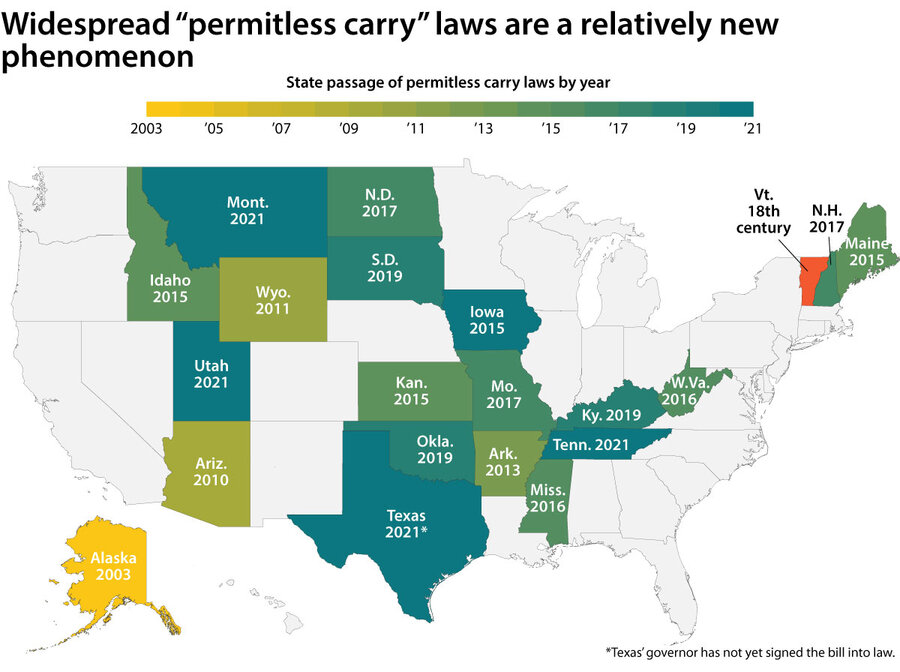
Handgunlaw.us
Supporters of permitless carry argue that it helps protect citizens’ Second Amendment rights and makes the public safer.
“Every law-abiding Montanan should be able to defend themselves and their loved ones,” said Gov. Greg Gianforte when he signed Montana’s permitless carry bill into law in February.
But the laws have also conjured up visions of Wild West-era lawlessness, and provoked fears of increased crime and violence. When Oklahoma adopted its constitutional carry law in 2019, local news reported that not much happened afterward, “at least on its first weekend.”
Law enforcement officials have publicly opposed permitless carry in many states. The Missouri Fraternal Order of Police did, as did all the county sheriffs in West Virginia. The public, including Republicans and gun owners, also often opposes scrapping permits.
In Kansas and Missouri, local law enforcement, government officials, and certified gun trainers told researchers with the Urban Institute in 2018 they mainly disapproved of permitless carry because training would no longer be required.
“Law enforcement was concerned with accidental shootings, or increased firearm thefts if guns are not secured properly,” says Paige Thompson, a researcher at the Urban Institute.
“It’s [also] very difficult for them to determine whether someone is ineligible to carry a firearm without a permit because there’s no [state] background check,” she adds, or “background checks for private sales.“
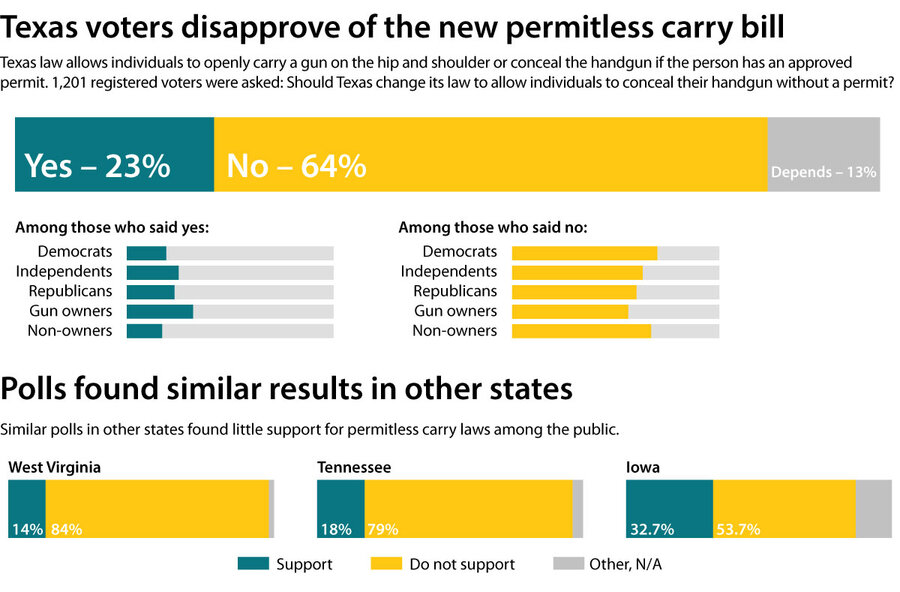
DMN/UT Tyler March 2020 poll, Everytown for Gun Safety February 2016 poll, Everytown for Gun Safety March 2019 poll, University of Iowa March-April 2021 poll
So who’s right? Does permitless carry increase safety, or violence? Since the laws are only a few years old, researchers say more time is needed to see if they have a notable effect on public safety.
“There hasn’t been much research on permitless carry,” says Andrew Morral, leader of the Gun Policy in America study initiative at the Rand Corp.
“Most of the research has been done looking at ‘shall issue’ concealed carry laws versus ‘may issue’ concealed carry laws,” he adds.
In “shall issue” states, applicants generally get permits if they meet the requirements. In “may issue” states, meanwhile, law enforcement has some discretion to deny permits to certain individuals. It’s here, where research has been building for decades, that experts are beginning to draw some conclusions.
John Donohue, a professor at Stanford Law School who has been studying gun policy for decades, says it took about 20 years “before I was able to draw a strong conclusion about the impacts of the laws.”
His conclusions, outlined in a 2019 paper, include the findings that more permissive gun carry laws are associated with rates of violent crime that are 13% to 15% higher 10 years after adoption. Other research has tied more permissive gun carry laws to increased firearms homicides.
For permitless carry laws specifically, crime statistics show little significant change – at least that can be attributed to the laws themselves.
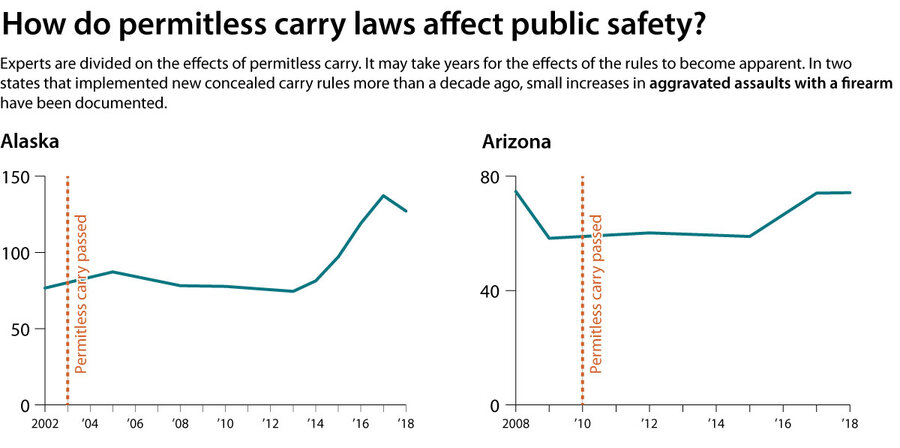
Alaska Department of Public Safety, Arizona Department of Public Safety, U.S. Census Bureau
“It has been difficult to study [permitless carry law] effects given the short timeline,” says Dr. Spitzer.
And to the counterargument, he adds, “there is no evidence that civilian gun carrying has any beneficial effect on suppressing, stopping, or reducing crime.”
An analysis of several thousand gun policy studies by the Rand Corp. last year found that evidence that concealed carry laws increase homicides and other kinds of violent crime is limited at best, but mostly inconclusive.
“The research is improving in this area,” says Dr. Morral. Unfortunately, he adds, “I don’t think the data is improving. In some ways the data is moving backwards.”
The FBI, for example, changed the program it uses to collect local crime data this year. The new program will allow for more detailed reporting, but reporting is voluntary. Dr. Morral and others have concerns that participation will drop off and there will be less data to study.
For now, it’s hard to deliver a conclusive verdict on what effect permitless carry laws have on public safety, if they have an effect at all.
Rand surveyed a range of experts – including academics, advocacy groups, and legislative staff – on how adopting permitless carry nationwide could affect public safety, for example.
Responses diverged significantly.
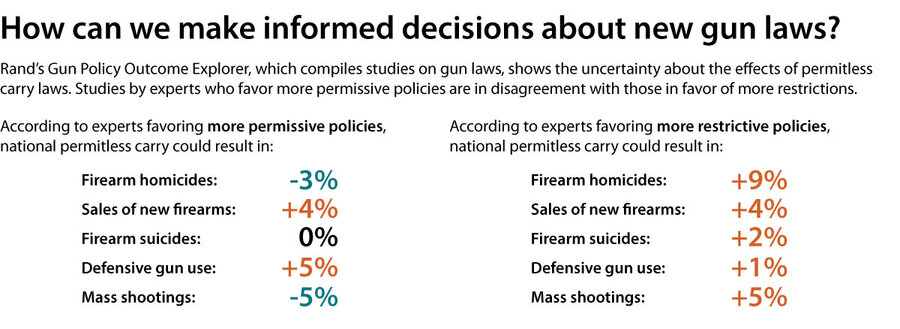
RAND Gun Policy Outcome Explorer
In its next term, the U.S. Supreme Court will hear a case concerning a restrictive New York concealed carry law, its first big Second Amendment case in more than a decade. The court has to date ruled only that the Second Amendment protects having a handgun in the home for self-defense. This case could see that protection expanded to handgun possession outside the home.
The gun rights landscape could thus be poised for even greater change. Whichever direction the statistics and research take, politics will continue to play a powerful role.
“Over a considerable period of time, [the evidence] was murky enough that the theoretical arguments against [permissive carry] laws were not powerful enough to stop them,” says Dr. Donohue.
“Now the political dynamics are so powerful that even with the evidence becoming more clear, the political dynamics are dominating the best empirical evidence.”
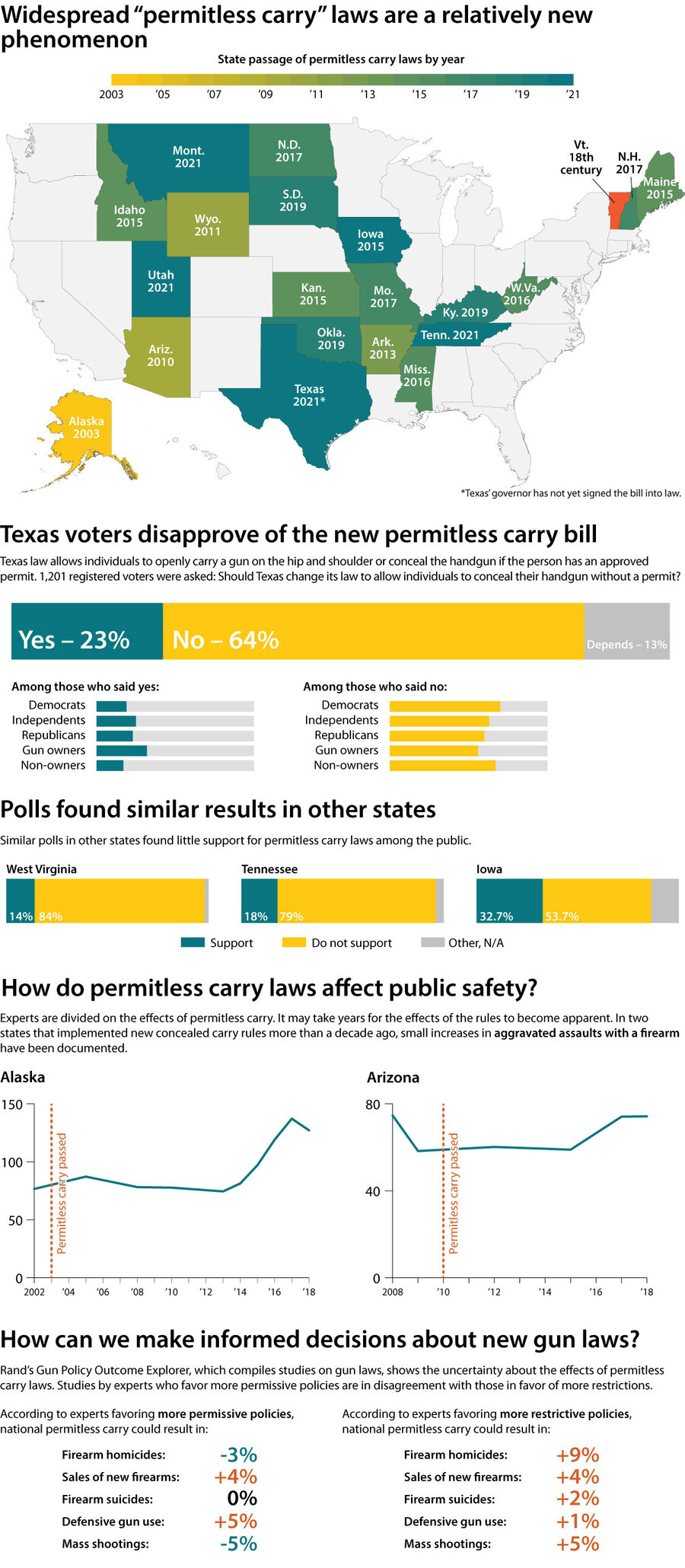
Handgunlaw.us, DMN/UT Tyler March 2020 poll, Everytown for Gun Safety February 2016 poll, Everytown for Gun Safety March 2019 poll, University of Iowa March-April 2021 poll, Alaska Department of Public Safety, Arizona Department of Public Safety, U.S. Census Bureau, RAND Gun Policy Outcome Explorer

Denmark evicts ‘ghetto’ residents to integrate them. Will it help?
How does a country alleviate poverty and segregation? Denmark is attempting to improve societal integration of “non-Western” citizens. We look at how that’s working.
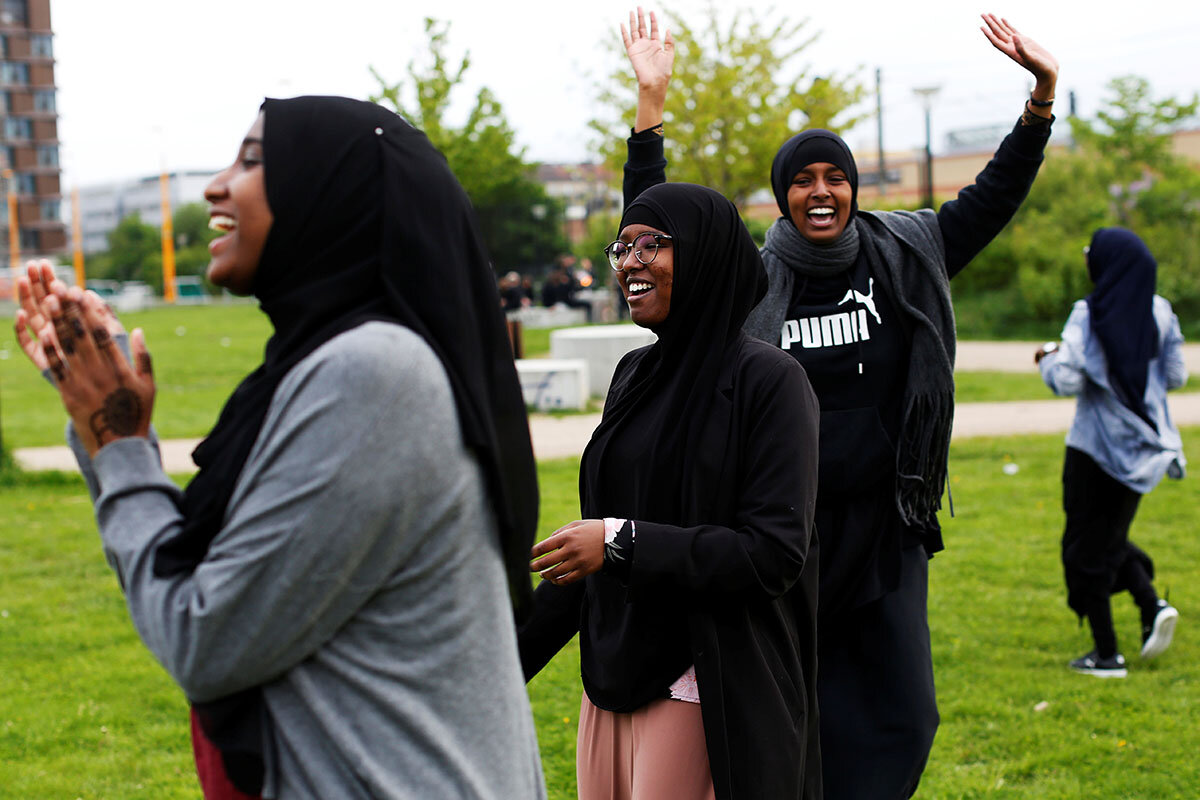
- Quick Read
- Deep Read ( 6 Min. )
-
Brendan Sweeney Correspondent
For Denmark’s policymakers, neighborhoods like Vollsmose, in Odense, are problematic. The state officially labels such areas ghettos if they meet certain criteria on unemployment, crime, education levels, and income, and if more than 50% of residents are considered “non-Western.”
So the government is requiring ghetto residents to relocate to other neighborhoods and demolishing their homes.
The Danish welfare system is one of the most generous in the world, built upon high taxes and a duty-bound concept. It doesn’t work when a society has low “social cohesion,” say economists. On the surface, the ghetto laws purport to better help integrate non-Western foreigners into Denmark’s social fabric. Yet, by targeting neighborhoods in part by the background of their residents, the government might be penalizing the very people it purports to help.
“How can you have a successful integration if my home is razed to the ground, and I’m thrown out of my home and rehoused somewhere else in the city?” says Ibrahim El-Hassan, a born-and-raised Dane whose family is facing eviction due to government policy. “We have no plans to leave Vollsmose. We will fight to stay with our last breath.”
Denmark evicts ‘ghetto’ residents to integrate them. Will it help?
Hans Christian Andersen was born in Odense, the third-largest city in Denmark, and a museum complex dedicated to him sits near the city center.
Across town to the northeast lies the country’s largest ghetto – an official term used to designate disadvantaged areas with a majority of “non-Western” residents.
And today, in a turn that could come from one of Mr. Andersen’s fairy tales, the residents of the neighborhood of Vollsmose face the prospect of having their public housing demolished and being sent to live elsewhere – all in the name of a 2018 law that aims to take apart “parallel societies.”
The Danish welfare system is one of the most generous in the world, built upon high taxes and a duty-bound concept. It doesn’t work when a society has low “social cohesion,” say economists. On the surface, the ghetto laws purport to better help integrate non-Western foreigners into Denmark’s social fabric. Yet, by targeting neighborhoods in part by the background of their residents, the government might be penalizing the very people it purports to help.
“The research has shown that it’s hard to promote integration into Danish society,” says Rasmus Landersø, an economist and director of research at the Rockwool Foundation Research Unit in Denmark. The new policy “is about reversing the trends of newly arrived immigrants being allocated over decades into certain areas with social housing, with a minority population coming into a majority cultural background. These trends have been created over decades and these are very fundamentally difficult problems to solve.”
“People in these areas have been left behind”
To be labeled a ghetto under the 11-year-old Danish law, an area must be more than 50% “non-Western,” and also match criteria on employment levels, crime statistics, education levels, and gross incomes.
Vollsmose sits squarely within the government’s designation – and because of its size and media attention on persistent social problems, it’s become a byword for failed integration. Roughly two-thirds of residents are non-Western, most of whom are Muslims hailing largely from Lebanon, Somalia, and Iraq, with more than 70 nationalities represented in total. Most Vollsmose residents are out of work, and incomes tick in at just over half the regional average.

That’s not a recipe for success, according to the Danish interior ministry, and its most recent policies deem that neighborhoods must be better “mixed.” “For too long people in these areas have been left behind,” says Kaare Dybvad, minister of the interior and of building and housing, in a supplied statement. “It is necessary to take responsibility for the development in residential areas to ensure equal opportunities.”
Having his home neighborhood of Vollsmose be labeled a ghetto angers Ibrahim El-Hassan, a born-and-raised Dane whose family lives there and is facing eviction due to government policy.
“The word ghetto is really stigmatizing,” says Mr. El-Hassan, a university student whose parents were Palestinian refugees who arrived in Denmark as children. “I have to live with the fact that I have the wrong ethnicity, the wrong religion; I live in the wrong place, ‘in a ghetto.’ Denmark is the only Western country that uses this term at the state level and integrates it into legislation.”
Being deemed a ghetto means Vollsmose is slated to eventually see 1 in 3 homes pulled down and more than a third of its 9,000 residents relocated.
It’s all part of a plan to promote “Danish values.” The laws include greater punishments for crimes committed in ghettos, and the potential to halt social support for various infractions such as having children who are truant or don’t attend external child care for a certain number of hours in a week.
Protecting the Danish social compact
Indeed, Denmark is struggling to smooth out conflicts that have arisen from integrating new groups into what was a largely homogeneous population 30 years ago.
For one, Denmark has one of the highest female labor participation rates in the world, and the welfare state is “very much built on the fact that both genders in a union work” outside the home, says Merlin Schaeffer, sociologist at Copenhagen University.
“Now, you have [newcomer] populations who were not super qualified for employment but also tend to have a rather more conservative family model, where oftentimes the wife is a homemaker,” says Dr. Schaeffer. “At some point Danes thought this was a cultural thing, because many don’t adapt to the more egalitarian model where both genders work. That poses a problem for the welfare state. These families often overproportionally receive welfare benefits.”

Because Danes also pay such high taxes to support one of the most generous welfare systems in the world, there’s a perception that immigrants aren’t pulling their weight by paying into the system, causing the fabric to erode, says Dr. Schaeffer. In 2001, Denmark spent 0.8% of gross domestic product on welfare benefits to immigrants from non-European Union countries, and only a touch more on the military at 1.2%. Shortly after that, politicians began to discuss policies tightening social benefit payments to certain populations, and the ghetto list came into being.
Government officials have said that relocations aren’t based on ethnicity or national background, as such a move would be unconstitutional. Yet opponents of the policies call discriminatory the practice of labeling ghettos. Such policies can ultimately be used to force the demolition, sale, or privatization of public housing, and altogether cause “differential treatment” based on ethnicity, say the laws’ opponents.
Ferruh Yilmaz, an expert on Muslim immigration, says that a perceived “crisis about immigrants’ cultural values” is the work of the far-right, a phenomenon also observed in places like Germany, which has taken in a million migrants over the last five years.
“Maybe it isn’t the culture but discrimination that is the problem,” says Dr. Yilmaz. “If you look at any country on earth, you’ll see that crime is concentrated in areas with poverty, which in turn is commonly the product of racial, ethnic, or religious discrimination, rather than their inhabitants’ lack of Western reasoning.”
“We have no plans to leave”
Discrimination aside, there are challenges to continuing to slot new arrivals into neighborhoods that are increasingly crime-ridden and where residents are underemployed. For one, where one lives can greatly shape a future, according to research.
“If you’re placed in a municipality where employment rates are higher, your own probability of finding work is higher,” says Marie Schultz-Nielsen, a senior researcher at the Rockwool Foundation Research Unit in Copenhagen. Learning Danish can also be easier in more integrated neighborhoods.
On top of that, the men living in ghettos may not have the job skills to immediately find employment. Housing in Denmark’s large cities can be prohibitively expensive, which can prevent the social mobility that comes with moving to a different neighborhood.
Ultimately, there’s a sense among the law’s proponents that immigrants aren’t pulling their weight. When it comes to neighborhoods, there’s also the concern that you reach a “tipping point where native Danes don’t want to move to that area,” says Dr. Landersø. “And then you get a kind of vicious circle.”
Mr. El-Hassan’s parents arrived in Denmark when they were ages 9 and 13. Vollsmose is their home, and they will combat pending demolition and relocation plans via the legal system. “We have no plans to leave Vollsmose. We will fight to stay with our last breath,” says Mr. El-Hassan.
In Mjølnerpark – a ghetto in Copenhagen – a dozen residents are suing the minister for housing for discrimination. A resident for 27 years, Asif Mehmood is party to one of the lawsuits. He ponders how his wife will possibly access the heart and kidney treatments she needs four times a week if they were forced to move away from their local hospital.
The United Nations has kept an eye on the fight, saying that the country should halt sale of houses in ghettos until its courts can rule on whether human rights are being violated.
Mr. El-Hassan acknowledges many of the public housing districts have social problems, but believes the ghetto laws, in force since 2010, are counterproductive.
“How can you have a successful integration if my home is razed to the ground, and I’m thrown out of my home and rehoused somewhere else in the city?” says Mr. El-Hassan. Also, Vollsmose residents with more resources are beginning to move out, further stigmatizing the poorer and most vulnerable residents left behind. He believes the residents should be helped where they live rather than being forced out.
Ultimately, these are large societal issues that shouldn’t be placed solely on the shoulders of minorities, says Mr. El-Hassan. “No one is talking about the responsibility of the majority culture.”

Points of Progress
Everything in its place: From stolen art to endangered monkeys
This week’s progress roundup highlights restitution, restoration, and renewal efforts ranging from Germany returning looted Nigerian antiquities to creating habitat corridors for wildlife in Brazil and Zimbabwe.
Everything in its place: From stolen art to endangered monkeys
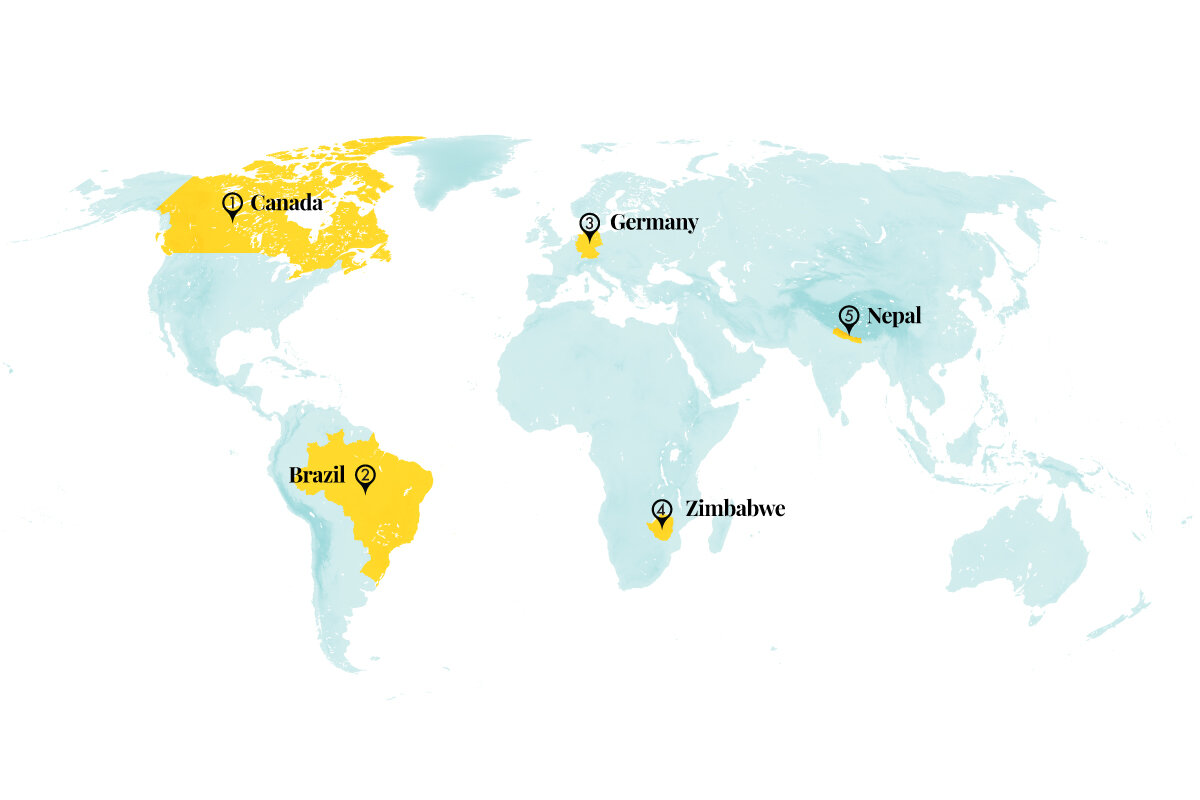
This week we look at returning things to their original state, from preserving cultural heritage by sending antiquities home, to removing landmines from a part of Zimbabwe to benefit people and the animals moving through the great wildlife reserves in southeast Africa.
1. Canada
Digital media startups are helping revive local journalism in Canada. The consolidation of major media companies and a decline in traditional advertising have resulted in mass layoffs and community newspaper closures. And despite government initiatives to mitigate the trend, another 52 newspapers shut their doors this past year. But a growing number of online outlets are looking to fill those news deserts and change the journalism landscape.
Overstory Media Group represents several newsletter-based publications covering specific communities in British Columbia. Inspired by their members’ success, the group plans to launch 50 outlets and hire 250 journalists in towns across the country by 2023. At the same time, a separate network of independent news outlets, Indiegraf, is hoping to bring new voices into journalism by removing the barriers to launching a subscription-based startup. So far, it’s supported 18 community-focused outlets with a suite of pooled resources, such as web developers and marketing staff.
Canadaland, The Guardian
2. Brazil
The effort to save Brazil’s rarest primate is slowly bearing fruit, and being hailed as a prime example of collaborative conservation. Habitat fragmentation has long threatened the black lion tamarin, a monkey endemic to Brazil’s southeastern state of São Paulo. A major wave of settlement in the 1940s destroyed more than 80% of the state’s Great Pontal Reserve forests, and for decades, people believed the black lion tamarin was extinct.
Researchers from the Institute for Ecological Research (IPÊ) knew that restoring the primate’s landscape meant engaging with the settlers. IPÊ designed a network of forest corridors based on wildlife tracking data, and refined the plan through a series of “eco-negotiations’’ with the local communities. Buffer zones are created by planting trees on farmland along forest fragments, while about 50 families are growing “steppingstone” forests, 2.5-acre chemical-free coffee orchards interplanted with food crops that wildlife can use to cross between habitats. To date, IPÊ and its partners have planted more than 2.7 million tree seedlings and restored 7,410 acres of forest in the Great Pontal Reserve. Meanwhile, the black lion tamarin was removed from the critically endangered list, with a current population of about 1,800 in the wild.
Mongabay
3. Germany
Germany is set to be the first country to return the Benin Bronzes looted by British soldiers and sailors in 1897. The British Museum holds the largest collection of Benin Bronzes, but many of the artifacts were sold to museums across Europe and North America. German institutions in Berlin, Cologne, Dresden, Hamburg, Leipzig, and Stuttgart collectively hold more than 1,500 items from the theft.

Culture Minister Monika Grütters announced that Germany will present a legal and logistical road map for their restitution by the end of June, with the first transfer occurring next year. The art’s path forward is not entirely clear, but the creation of Legacy Restoration Trust (LRC) – a new, politically neutral organization that can receive the Benin Bronzes – helped facilitate Germany’s decision. “This is a huge step towards righting what is wrong, especially coming from a country that was a superpower in colonisation,” said Nigerian artist Victor Ehikhamenor, an LRC trustee. “Germany has chartered a path for other western countries struggling to find the right way to handle restitution cases.”
The Guardian
4. Zimbabwe
A project is underway to demine part of the largest contiguous wildlife area in the world. With U.S. and Swiss aid, Belgian demining organization APOPO is clearing more than 1,700 acres of Zimbabwe’s Sengwe Wildlife Corridor, part of the Great Limpopo Transfrontier Park (GLTP). During Zimbabwe’s 1964-79 civil conflict the Rhodesian army laid dense minefields to limit the movement of guerrilla fighters. This critical area allows wildlife to freely migrate between South Africa’s Kruger National Park and Zimbabwe’s Gonarezhou National Park, helping stabilize populations.

For 40 years, hidden anti-personnel land mines have endangered GLTP’s wildlife, including elephants and pangolins, and threatened the safety and livelihoods of thousands of families living near the park. APOPO has already cleared more than 10 acres of land, and the team expects to locate and eliminate roughly 15,300 mines by the end of the project. Coordinators say the corridor will be mine-free by 2025.
Apopo, Swiss Federal Department of Foreign Affairs
5. Nepal
In a win for local Indigenous groups, the European Investment Bank (EIB) vowed to address gaps in the implementation of a hydropower project in central Nepal. As a signatory to the International Labor Organization’s Convention 169, Nepal is legally bound to protect the rights of Indigenous peoples, who are entitled to consultation on any issues relating to the development of their traditional lands and resources. But communities around the world say renewable energy projects often fall short, including the Marsyangdi Corridor transmission line, a high-voltage power line set to run through forests and ancestral lands of hundreds of households in Nepal’s Lamjung district. EIB failed to adequately assess the line’s environmental and social impacts, according to a complaint filed in 2018, and did not obtain consent from affected residents.
The bank recently concluded that at least some of these claims were substantiated, and has hired an independent local expert to help correct the mistakes. EIB will also launch a public review of its social and environmental policies. Anirudha Nagar, communities director of the Accountability Counsel advocacy group, says this investigation “has far-reaching impacts for internationally financed development projects impacting the lands of indigenous peoples, both in Nepal and beyond.”
Thomson Reuters Foundation, Accountability Counsel, European Investment Bank
World
In an effort to combat art crime, Interpol has launched an app allowing mobile phone users to identify stolen artwork using a sophisticated image recognition program. ID-Art is a new tool to help recover lost pieces and deter art and artifact trafficking, a trade worth $10 billion annually, according to UNESCO estimates, making it one of the most profitable black markets in the world.
After downloading the app, users can photograph an art piece, upload an existing image, or use descriptive terms to search Interpol’s database of lost and stolen art, which includes more than 52,000 items. If the art in question appears to match a registered piece in Interpol’s database, the app prompts users to report it. During its pilot phase, ID-Art helped authorities recover two sculptures and two paintings in Europe. Loose requirements for tracking the chain of ownership mean that stolen pieces can often surface at legitimate auction houses, museums, or private collections, and with the new app, authorities say buyers and sellers will have little excuse for ignorance.
Forbes, Organized Crime and Corruption Reporting Project
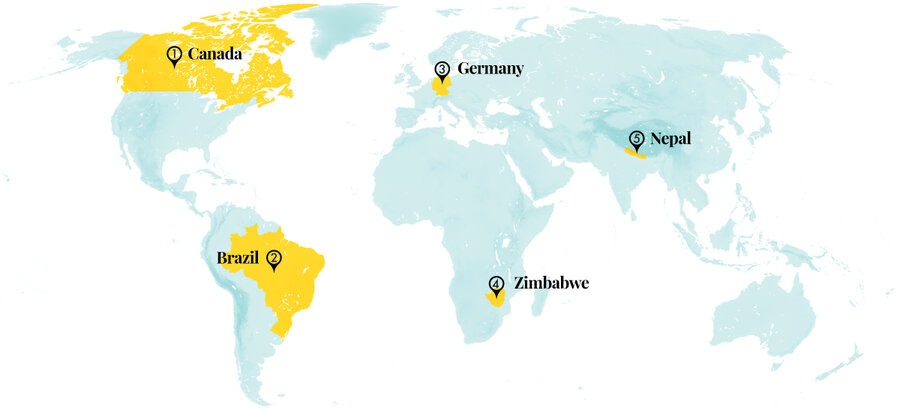

Commentary
Sports team owners and the call for racial justice
The silence of sports team owners was conspicuous during last year’s racial reckoning. Our columnist observes that social justice may not occur until wealthy owners, who are mostly white, assume a leadership role.
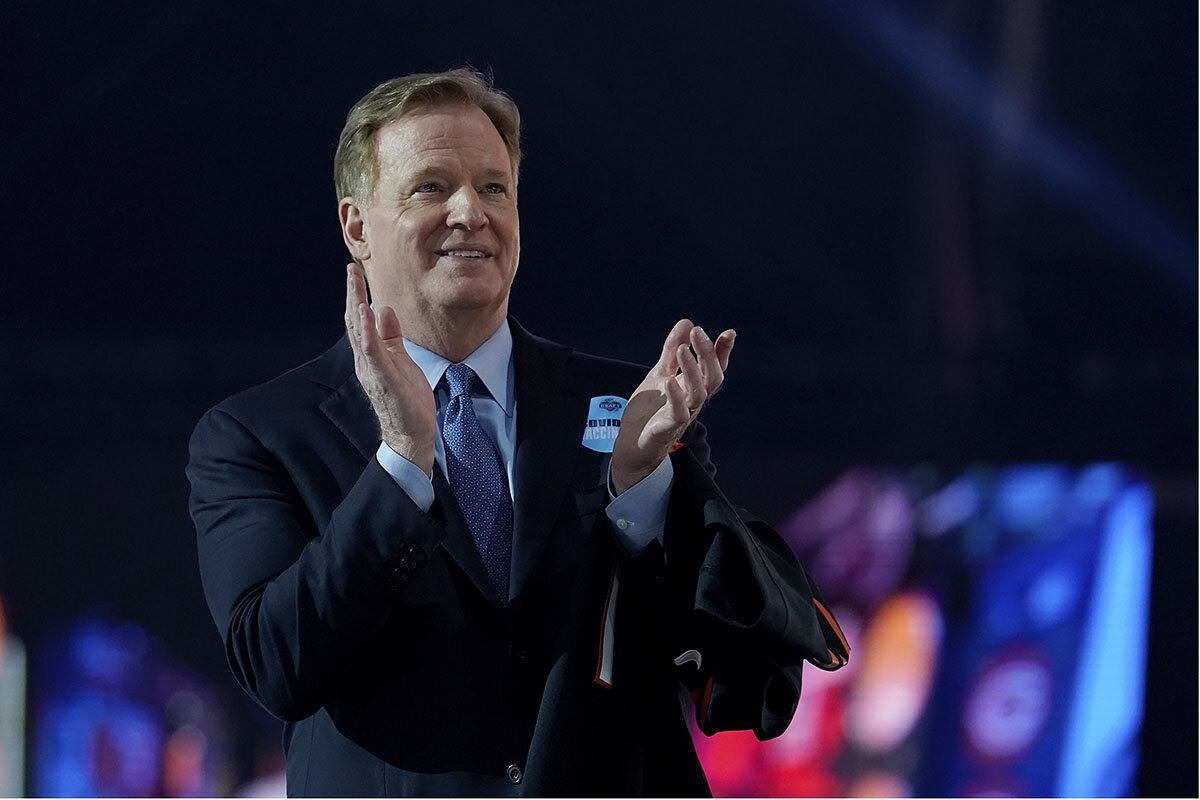
- Quick Read
- Deep Read ( 5 Min. )
Historically, star athletes of color have taken the burden of responsibility on themselves when it comes to racial justice in sports. The calls for change have not begun in the luxury boxes or executive suites. One reason is obvious: Major league team owners are almost all white; there are only six exceptions in the NBA, NFL, and MLB.
But the pressure for owners to speak up is mounting. In the wake of George Floyd’s murder by police in Minneapolis, NFL Commissioner Roger Goodell publicly condemned “racism and the systematic oppression of black people.” Less than a year later, after Daunte Wright was killed by police near Minneapolis, Gregg Popovich, the elder statesman of NBA coaches, spoke up.
Still, a marked split remains between owners and players. Based on a report of 2019-2020 political contributions, team owners supported Republican interests and causes at nearly an 86% clip. Comparable data for players is not available, but the racial justice issues they have endorsed typically find more support from Democrats than Republicans.
One path forward might be for owners to organize in the spirit of social justice from the outset. That’s what the majority-women owned Angel City FC women’s soccer team in Los Angeles is doing.
Sports team owners and the call for racial justice
It had been nearly two weeks since the death of George Floyd at the hands of police sent shock waves through the United States. The residents of Minneapolis and protesters had their say. Now, the world of sports would speak out. The NFL, long maligned for its actions toward Colin Kaepernick, stunned the public with a commentary from Commissioner Roger Goodell:
We, the National Football League, condemn racism and the systematic oppression of black people. We, the National Football League[,] admit we were wrong for not listening to NFL players earlier and encourage all to speak out and peacefully protest. We, the National Football League, believe black lives matter.
Mr. Goodell’s words came a day after players collaborated on a video that challenged the NFL to take a stand against social injustice. The players were on board, and the commissioner, the primary representative for the owners, was on board. Only one thing was missing – the owners themselves.
Historically, star athletes of color have taken the burden of responsibility on themselves when it comes to racial justice in sports. The calls for change have not begun in the luxury boxes or executive suites. One reason is obvious: NBA, NFL, and MLB teams’ primary owners are almost all white; there are only six exceptions.
By comparison, the NBA, NFL, and MLB all have a high number of players of color – roughly 81%, 73%, and 43% respectively. Until very recently, the athletes speaking up were those who felt the sting of prejudice and injustice personally and felt morally obligated to use their power for more than endorsement contracts.
The pressure for that to change is mounting. Less than a year after Mr. Floyd’s death, another Black man, Daunte Wright, was killed by police in Brooklyn Center, about 10 minutes from Minneapolis. This time, when the world of sports spoke up, it was the elder statesman of NBA coaches, Gregg Popovich:
How many young Black kids have to be killed for no ... reason? How many? So that we can empower the police unions? We need to find out who funds these people. I want to know what owners in the NBA fund these people who perpetrate these lies. Maybe that’s a good place to start, so it’s all transparent.

Owners’ investments – and actions
The split between owners and players was underlined by a USA Today article last October that reviewed the political contributions of 183 team owners from 2019-2020. The results showed that the majority of owner money supported Republican candidates or causes. The margin wasn’t even close – Republican interests and causes had been supported at nearly an 86% clip. Comparable data for players is not available, but the racial justice issues they have endorsed typically find more support from Democrats than Republicans.
The imbalance in owners’ political contributions leads some players to essentially write them off as potential allies in racial change. Said LeBron James: “I’m not going to give my energy to that, because it’s not surprising. My mom has always told me, control what you can control. And I can’t control that. What I can control is what I’m doing on my side.”
But an earlier tale of two owners decades ago hints at the potential for a different picture.
Nearly 60 years ago, NBA luminary and legend Bill Russell led a boycott of a preseason exhibition game in Lexington, Kentucky, after two of his teammates were refused service at a segregated coffee shop. Eventually, seven players, all Black, participated in the boycott – five Celtics players and two St. Louis Hawks players, Cleo Hill and Woody Sauldsberry.
There was a stark difference in the response from Celtics owner Walter Brown and Hawks owner Ben Kerner. Mr. Brown told Celtics coach Red Auerbach that the exhibition should have never been played after the players were refused service and declared that he would “never subject my players to that embarrassment again.”
Mr. Kerner, meanwhile, traded away two of the Hawks’ three Black players, including Mr. Sauldsberry. After a coaching change, Mr. Hill, the lone Black player on the team, was virtually blacklisted. In 1968, Mr. Kerner sold the franchise to Thomas Cousins and former Georgia governor Carl Sanders. The piece about selling to a Georgia governor is ironic, if nothing else, because of MLB’s recent decision to move the All-Star Game in light of criticisms that state Senate Bill 202 encourages voter suppression.

A new approach
The path forward might certainly contain a spirit in ownership that not only protects the right to protest, but promotes it through financial support. Another path lies in understanding the power of ownership that organizes in the spirit of social justice from the outset.
Last July, Angel City FC, the group working to bring a women’s soccer team to Los Angeles, was founded. Its high-profile owners and investors include actor Natalie Portman, tennis luminary Serena Williams, and more than a dozen former U.S. women’s national soccer team stars. Angel City FC is majority-women owned and will join the National Women’s Soccer League in the spring of 2022. In her first letter as co-founder and president, Julie Uhrman affirmed Angel City FC’s commitment to “think differently about ownership” and “make a positive impact on our local community.”
Founding investor Alexis Ohanian, Ms. Williams’ husband and the co-founder of Reddit, acknowledged that while this is a “business decision,” there are a lot of good “social reasons” for the decision:
The athletes are far more popular and have already transcended the sport and culture. And while I am all for [what] this represents – a generation of athletes who should get paid what they’re worth, who should get treated fairly and equally – I also know this is tracking in the right direction. The free market is actually going to show that this has been undervalued for way too long by far too many people.
It’s promising to think of a world where franchise owners, with the amount of wealth they have amassed, take the lead when it comes to social awareness. Once it happens with regularity, then it won’t just be an issue of small change. The money – and the movement – will start to turn in a way that helps everyone.
Other headline stories we’re watching
(Get live updates throughout the day.)The Monitor's View
Iraq crosses a democratic threshold
- Quick Read
- Deep Read ( 2 Min. )
-
By the Monitor's Editorial Board
Young people in Iraq, whose protests in 2019 brought a democratic reformer to power, are holding their breath. On May 26, for the first time the Iraqi government arrested a senior commander of a pro-Iran militia and – here is the breath-holding part – he has not been released more than a week later. In addition, an attempt by the commander’s militia to besiege the capital and pressure his release was repelled by elite Iraqi forces.
While the arrest of Qasim Muslih on terrorism charges is small on a global scale, it represents a significant advancement in rule of law and accountability in a country pivotal to the growth of democracy in the Middle East. No senior member of the many Iran-backed militias that reject government control has been held accountable for the killing of pro-democracy activists over the past two years.
Iraq’s attempt to establish a stable, secular democracy in the heart of the Arab world has been a long process of adopting the key building blocks of democracy. Since the May arrest of a key militia leader, rule of law may be one block more firmly in place.
Iraq crosses a democratic threshold

Young people in Iraq, whose protests in 2019 brought a democratic reformer to power, are holding their breath. On May 26, for the first time the Iraqi government arrested a senior commander of a pro-Iran militia and – here is the breath-holding part – he has not been released more than a week later. In addition, an attempt by the commander’s militia to besiege the capital and pressure his release was repelled by elite Iraqi forces.
While the arrest of Qasim Muslih on terrorism charges is small on a global scale, it represents a significant advancement in rule of law and accountability in a country pivotal to the growth of democracy in the Middle East. No senior member of the many Iran-backed militias that reject government control has been held accountable for the killing of pro-democracy activists over the past two years. And previous attempts at arresting the militia members of Mr. Muslih’s Kataib Hezbollah group ended up with them being quickly released.
His arrest is even more significant as it comes just four months before parliamentary elections, giving hope that voters and candidates can enjoy peaceful campaigning and that the integrity of the electoral process will be upheld.
“Either the state proceeds to sovereignty and order, or the state falls on everyone’s heads,” tweeted a former prime minister, Haider al-Abadi, after the arrest. He added that “no one is above the law.”
In addition, a successful election in Iraq would stand in contrast to a June 18 presidential election in neighboring Iran, where candidates are carefully chosen by ruling Islamist clerics whose attempts to control Iraq include the backing of several militias.
Since taking office just over a year ago, Iraqi Prime Minister Mustafa al-Kadhimi has slowly gained enough political strength to bring some rule of the law to a state that relies heavily on a division of government spoils among Iraq’s ethnic and religious groups. With the help of the United Nations, he has improved the mechanics for a neutral election, one in which he claims he will not run. He has beefed up border security with Syria, partly cutting off illegal trade that helps fund some militias. He has appointed many officers in the armed forces, replacing those who have supported militias close to Iran. And he has ordered state institutions to stop classifying Iraqis by their religious affiliation.
Iraq’s attempt to establish a stable, secular democracy in the heart of the Arab world has been a long process of adopting the key building blocks of democracy. Since the May arrest of a key militia leader, rule of law may be one block more firmly in place.

A Christian Science Perspective
Each weekday, the Monitor includes one clearly labeled religious article offering spiritual insight on contemporary issues, including the news. The publication – in its various forms – is produced for anyone who cares about the progress of the human endeavor around the world and seeks news reported with compassion, intelligence, and an essentially constructive lens. For many, that caring has religious roots. For many, it does not. The Monitor has always embraced both audiences. The Monitor is owned by a church – The First Church of Christ, Scientist, in Boston – whose founder was concerned with both the state of the world and the quality of available news.
Healing’s deeper reward: Experiencing God
- Quick Read
- Read or Listen ( 4 Min. )
-
By Tony Lobl
Christ Jesus’ teachings and example offer a powerful basis not only for the healing of mental and physical problems, but also for a transformative shift in perspective on the nature of existence.
Healing’s deeper reward: Experiencing God
That Christian Science heals is attested to by a steady flow of healings of physical and mental illness, injuries, compulsive habits, etc. reported in the Christian Science Sentinel, The Christian Science Journal, and this very column in The Christian Science Monitor. Each of these publications has been published for over 100 years, and encompass many thousands of records of health restored.
But they record more than that. Each healing includes a shift in perspective – a thought turned Godward – that individually echoes the shift brought about for humanity by Christ Jesus. Through his spiritual discernment, his sense of God as his source – as Life and Truth itself – people were freed from ailments of all kinds. Yet that pointed to something Jesus considered even more valuable. After his followers reported their experience of healing, he said, “You should be happy, but not because the spirits obey you. You should be happy because your names are written in heaven” (Luke 10:20, International Children’s Bible).
Gaining this higher sense of our “name” (our true nature) as God’s heavenly (spiritual and harmonious) offspring is a distinct feature of Christian healing, as Mary Baker Eddy explained. Referring to cures of disease and reformation of character achieved through the ever-existent divine Science she discovered, she said in an address called “Christian Science versus Pantheism,” “All this is accomplished by the grace of God, – the effect of God understood” (p. 10).
If healing is the effect that comes with renewed spiritual understanding, it’s also fair to say that this understanding is itself the deeper gain that comes through a Christian Science healing. This stood out to me when a relative and a church friend living in the same part of London were both diagnosed with pneumonia at a local hospital. My relative was admitted to the hospital for medical care. My friend, whose diagnosis was at her family’s request, returned home, trusting the divine Science that had healed her for decades. She requested help from a Christian Science practitioner, who directly prayed for her, and a Christian Science nurse, who provided practical care in support of the spiritual basis of that prayer.
I was so grateful that both my relative and my friend fully recovered.
But the restorative agent in my friend’s return to health was very different from that experienced by my relative. It was a spiritual breakthrough. My friend had a priceless moment of divine grace as she read the Bible and the Christian Science textbook (Mrs. Eddy’s “Science and Health with Key to the Scriptures”). In that moment, her fear dissolved; she felt God’s presence as all-embracing, infinite Love; and she saw herself as God sees each of us: spiritual, perfect, intact. It took faith and persistence to attain this moment of inspired understanding. But when it came, healing was immediate and complete. No recuperation period was needed (see Angela Wallace, “Healed of pneumonia,” Sentinel, April 6, 2009).
Not every cure that comes through Christian Science is such a transcendent awakening to God’s ever-presence and our perfection as God’s creation. But all include some uncovering of divine reality. In this way, Christian Science shines a light on existence as truly spiritual instead of material, and as good rather than invariably prone to evil.
This spiritual reality sets in motion the dissolution of the general conviction that matter is the basis of our existence, the source that would define us. Healing happens through a mental shift to discerning that we are solely what’s “written” (true) in the ever-present heaven of Spirit’s harmony.
This idea of life being solely in Spirit, God, is Christ, the ever-present spiritual power exemplified in Jesus’ healings. Christ relieves suffering by uncovering the underlying health and peace that are the substance of our identity as Spirit’s expression.
Christ is lovingly communicating this divine reality to each individual, regardless of the method one chooses for healing, because God’s love is impartial. It is, however, hard to discern and yield to the spiritual truth of unending harmony when our hope is vested in something that’s intrinsically inharmonious, which is the case with all that’s material. As Science and Health explains, “Consciousness constructs a better body when faith in matter has been conquered. Correct material belief by spiritual understanding, and Spirit will form you anew” (p. 425).
Such Spirit-formed newness restores health by illuminating the transformative fact that everyone’s name is forever written in God’s heavenly kingdom of perpetual, spiritual goodness and grace.
Adapted from an editorial published in the June 7, 2021, issue of the Christian Science Sentinel.
Looking for more timely inspiration like this? Check out the “Related stories” below; explore other recent content from the Monitor’s daily Christian Science Perspective column; or sign up for the free weekly newsletters for this column or the Christian Science Sentinel, a sister publication of the Monitor.

A message of love
A passing glance
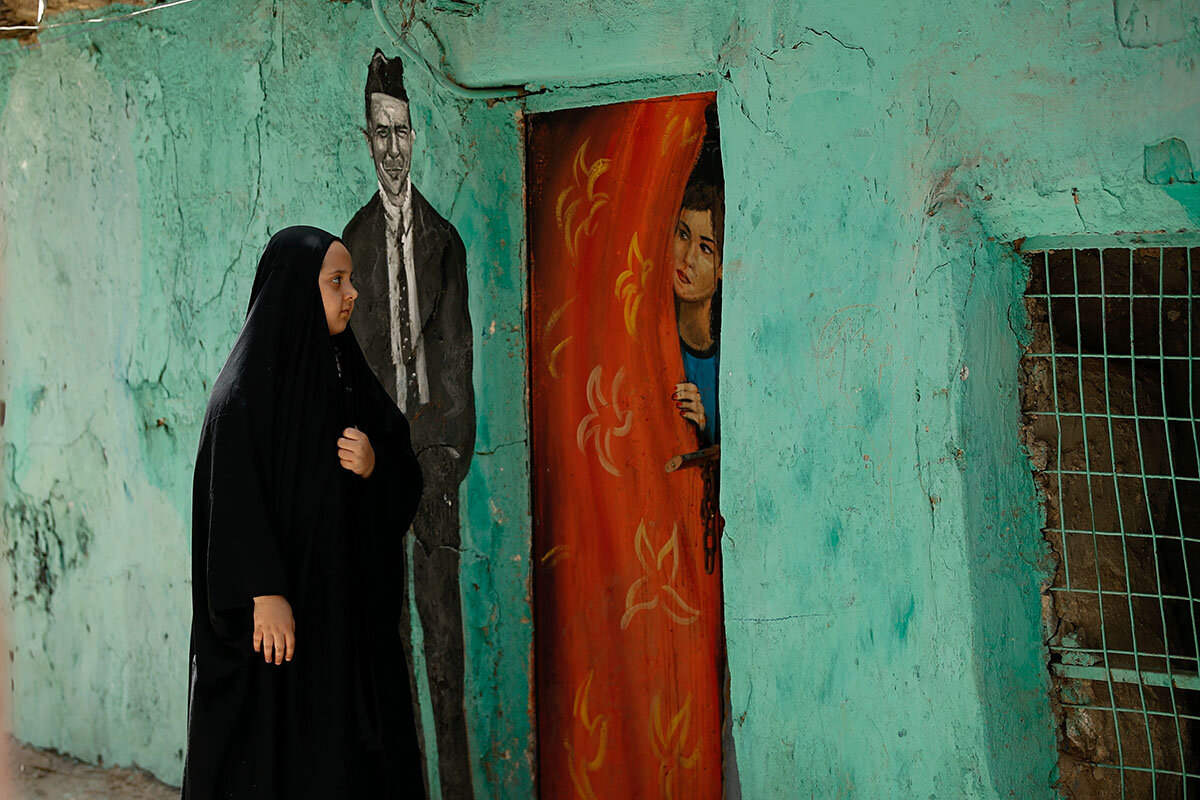
A look ahead
Thanks for joining us. Come back tomorrow: We’re working on a story about stitching lives back together with the help of secondhand sewing machines.
Finally, we invite you to meet the humanitarians solving community problems. Meet your fellow Monitor subscribers. Join the conversations at Community Connect webinar events. These events – and reporter profiles – are included in your subscription. It’s our way of connecting you with the work of good Samaritans in the world.




